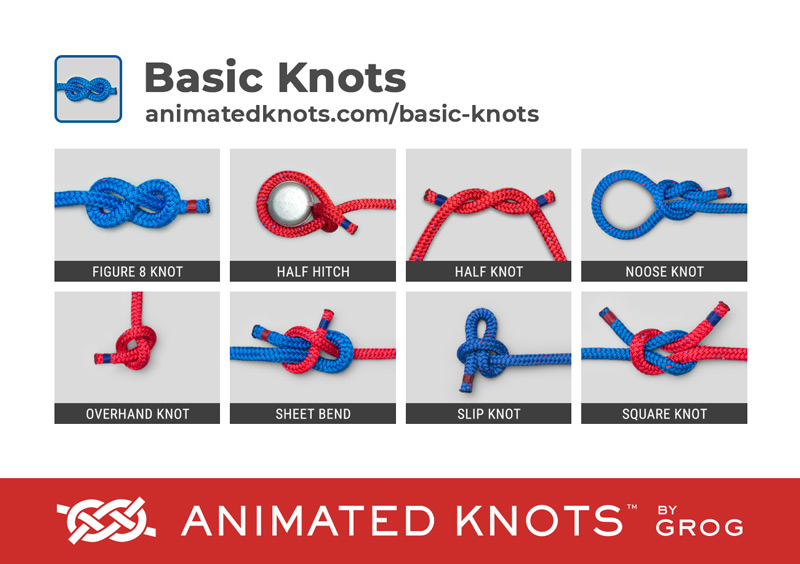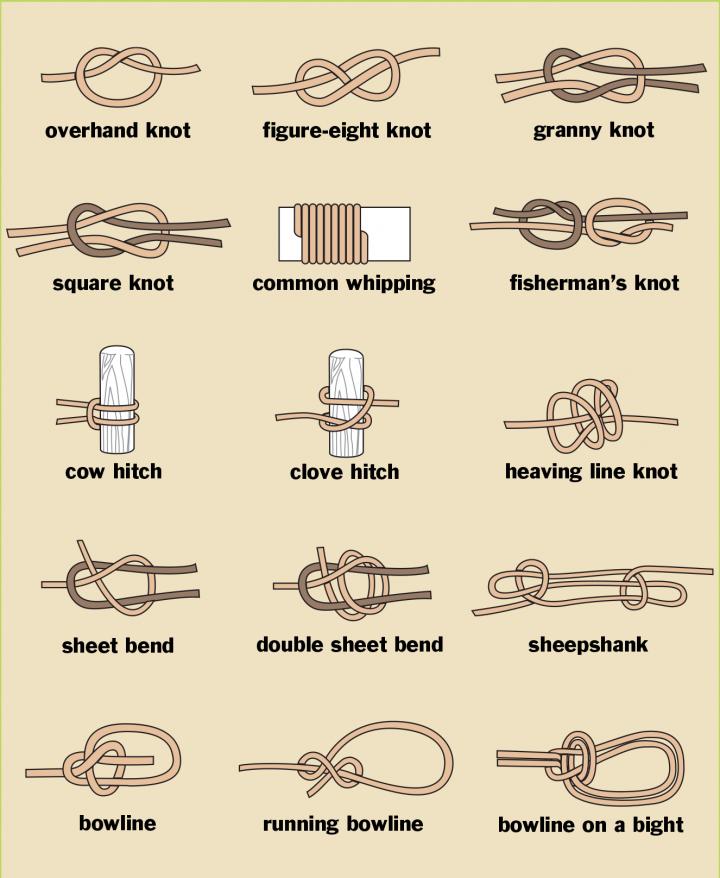Knots And Knots - Simple Connections, Deep Meanings
There is something rather captivating about a simple length of rope, isn't there? It might seem like just a basic tool, yet when you start to consider what it can do, it's quite astonishing. From holding things steady to helping you climb, or even just keeping a package together, rope shows up in so many parts of our daily existence. The magic, you see, often happens when that rope comes together, forming something useful and reliable. That's where the idea of knots and knots comes into play, a subject that is, in a way, far more interesting than it first appears.
You might think you know a thing or two about knots, perhaps from tying your shoes or securing a bag. But there's a whole universe of these clever twists and turns, each with its own special purpose and, frankly, its own little personality. We sometimes just take them for granted, yet they are, in fact, incredibly clever inventions, allowing us to connect, secure, and even rescue. It's not just about making a loop; it's about making the *right* loop, the one that will do exactly what you need it to do without letting you down, which is quite important.
So, we're going to take a closer look at these humble yet powerful creations. We'll explore some of the most basic ones, talk about why they are so vital, and even touch upon some of the deeper meanings people have found in them throughout time. It's a little bit of practical know-how mixed with some fascinating cultural tidbits, showing just how much these simple rope formations have shaped our lives and, you know, continue to do so every single day.
Table of Contents
- The Basics of Knots and Knots - What Are They Really?
- Why Do Knots Weaken Rope?
- More Than Just Holding Things - The Many Uses for Knots and Knots
- Are All Knots Created Equal? Sorting Out Common Mix-Ups
- Knots and Knots Through Time - What Stories Do They Tell?
- Finding Your Favorite Knots and Knots - Which Ones Should You Know?
The Basics of Knots and Knots - What Are They Really?
At its very core, a knot is, well, just a particular arrangement you make with a piece of rope. It’s created by, in a way, wrapping the rope around itself, or around another object, in a very specific pattern. These patterns aren't just random; they are put together to serve a particular purpose. Often, the main idea behind making a knot is to hold the rope firmly to itself, maybe creating a loop that won't slip, or to connect the rope to something else, like a post or another length of material. They are, you know, pretty much essential whenever you decide to use rope for anything at all, whether it's for something serious or just a simple task around the house. It's almost like giving the rope a job to do, and the knot is the way it does that job, more or less.
Starting Simple - Joining Ropes with Knots and Knots
When you have two separate pieces of rope and you need them to act as one, there are a couple of very straightforward ways to make that happen. The square knot, which some people call a reef knot, is one of those go-to options. It’s pretty simple to put together and, you know, often used for tying things that aren't under a lot of strain, like bundling up a tent or securing a package. Then there’s the sheet bend, which is another really fundamental way to connect two ropes, especially if they are of different thicknesses. This one is, arguably, a bit more secure when you’re joining ropes that aren't quite the same size. These two are, in some respects, the absolute starting points for anyone who wants to get a handle on connecting rope pieces, laying down the very basic foundation for more involved work with knots and knots.
The Figure Eight - A Core Knot and Knots Foundation
While the square knot and sheet bend are great for joining things, there's another knot that, in a way, serves as a building block for so many other important rope formations. This is the figure eight. It’s a pretty simple shape to make, looking, you know, like the number eight when you’ve finished it. But don't let its basic appearance fool you. This humble knot is, actually, the foundation for a whole host of other, more complex and useful knots. Many of the more specialized loops and connections you might encounter in various activities actually begin with, or incorporate, the basic structure of the figure eight. It’s almost like the alphabet of knot tying; once you get this one down, you’ve got a really solid base for learning so much more about knots and knots, which is pretty cool.
Why Do Knots Weaken Rope?
It might seem a bit counterintuitive, but while knots are absolutely necessary for using rope effectively, they do, in fact, have a bit of a downside: they tend to make the rope a little less strong. Think about it this way: when you tie a knot, you’re bending the rope sharply, and sometimes even crushing its fibers together in certain spots. This creates points of stress, places where the rope is, basically, not able to bear as much weight or pulling force as a straight, untied length of rope would. It's a bit like putting a kink in a garden hose; the water flow gets restricted. With rope, the strength gets reduced. The precise amount that a knot takes away from the rope’s overall ability to hold a load depends on one really big thing: the specific kind of knot you’ve put together. Some knots are, you know, much kinder to the rope’s fibers than others, causing less stress and thus preserving more of its original strength, which is something to keep in mind.
More Than Just Holding Things - The Many Uses for Knots and Knots
While we often think of knots as just a way to hold something still or to connect two pieces, their usefulness stretches far beyond those simple tasks. They are, in fact, incredibly versatile tools that can help with a wide array of situations. You might use them for securing items, making sure they don't move or fall. They are also, very, good for joining ropes together, as we've talked about, creating longer lines or complex setups. And, quite often, they are absolutely essential for adjusting how much pull or slack is in a line, allowing you to fine-tune the tension for a particular job. So, it's not just about, you know, dropping a line into the water or tying up a boat; there are so many other ways these clever rope formations come in handy, making them a really important part of many different activities.
Knots and Knots in Action - From Climbing to Tree Care
Let's look at some specific examples of where knots really shine. Think about people who climb mountains or big rocks; they use knots to keep themselves safe and to connect their gear. For instance, the anchor bend is a knot that climbers often rely on for securing their carabiners, which are those metal clips that connect ropes to other equipment. This knot gives them a really dependable connection, which is, obviously, super important when you're high up off the ground. And it’s not just for climbers. People who work with trees, like arborists, also find this knot incredibly useful. They might, you know, even use it when they are carefully moving up trees, showing just how adaptable these rope formations can be across different lines of work. So, you see, knots and knots are truly put to the test in situations where reliability is, quite frankly, everything.
Are All Knots Created Equal? Sorting Out Common Mix-Ups
When you start to talk about knots, you quickly realize that some of the names can get a little confusing. People often use certain terms as if they mean the same thing, even when they are, in fact, referring to distinct ways of tying rope. For example, the overhand knot, the half hitch, and the half knot are often jumbled together in conversation. They are, actually, different formations, each with its own specific characteristics and uses. Similarly, the slip knot and the noose are frequently confused. While they might look a little alike, their purposes and how they behave under strain are quite different. It's, you know, a bit like confusing a spoon with a ladle; both are for scooping, but for different kinds of scooping. Knowing the subtle differences between these commonly mixed-up knots is, basically, a step towards truly understanding how to use rope effectively and safely, which is pretty helpful.
Knots and Knots Through Time - What Stories Do They Tell?
Knots are not just about practical uses; they have, in some cultures, carried much deeper meanings for a very long time. Historically, some people saw knots as more than just a way to secure something; they viewed them as a form of protection, almost like a charm against bad things, or even as a symbol of freedom and release. It’s a pretty interesting thought, isn't it? Beyond their shape, the color of a knot can also hold important significance, especially in traditions like those found in Chinese culture. For instance, a red knot is, very often, seen as a symbol of good fortune and happiness. This idea of knots holding meaning is, you know, not unique to one place. Just like the Celts, who had their own intricate knot designs, these twisted rope patterns play a significant part in Chinese wedding ceremonies. You'll often see knots with names like the “true love knot” and the “double happiness knot” featured prominently at these celebrations, representing lasting connections and good wishes for the couple. So, you see, knots and knots are not just functional; they are, arguably, storytellers too, carrying traditions and beliefs through their very form.
Finding Your Favorite Knots and Knots - Which Ones Should You Know?
With hundreds, or even thousands, of different knots out there, each with its own particular job, it can feel a bit overwhelming to figure out where to even begin. Most people, you know, don't have the time to learn every single one, or to sift through a huge collection to find the absolute best knot for every little thing they might need to do. What tends to happen is that people develop their own personal collection of go-to knots, the ones they remember how to tie and, crucially, how to untie without too much fuss. These are, basically, the knots that become their reliable friends in various situations. If you're just starting out and don't yet have your own personal favorites among all the knots and knots out there, there are a few that come highly recommended for their general usefulness. One really good one is a versatile loop knot that, you know, just doesn't slip, and it’s also quite easy to undo, even if it’s been under a lot of strain. People often use this particular knot for things like hanging food bags out of reach of animals when camping, which is pretty handy. It’s a great starting point for anyone looking to build a useful set of knot-tying skills, which is a good thing to have.

Basic Knots | Learn How to Tie Basic Knots using Step-by-Step

Essential Knots for the Outdoors | Knots guide, Knots, Scout knots

How to Tie Knots: Tying Different Types of Knots with Illustrations